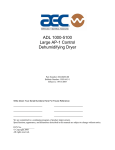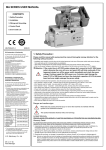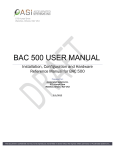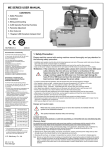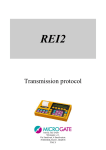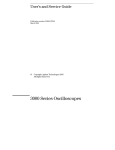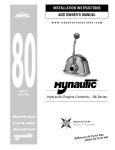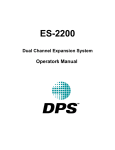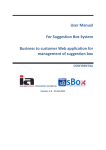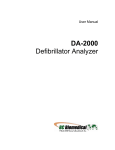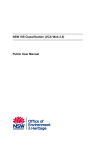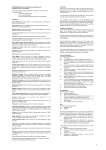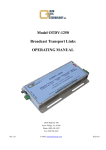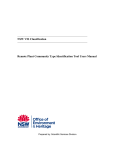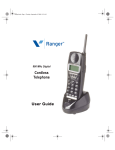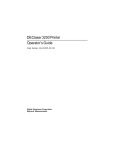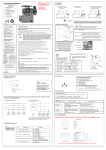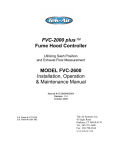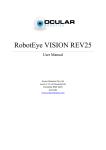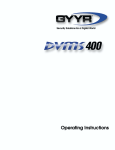Download DPS-465
Transcript
DPS-465 Serial Digital Video Synchronizer Operator’s Manual Copyright Information Copyright This document, the DPS-465 and all related materials are © Copyright 1997, Digital Processing Systems, Inc. All rights reserved. The printed version of this document is DPS Part Number 707-465, revision 2.01. Caveats Information in this document is subject to change without notice and does not represent a commitment on the part of Digital Processing Systems, Inc. This product requires technical and mechanical ability and requires precautions against electrostatic discharge. The user assumes all risks when this product is installed by anyone other than an authorized Digital Processing Systems dealer. i Table of Contents Copyright Information ......................................................................................................i Copyright...................................................................................................................................i Caveats.......................................................................................................................................i Introduction ........................................................................................................................... 1 Chapter 1: Installation and Configuration ........................................................ 2 Installation .............................................................................................................................. 2 Unpacking and Inspection ..................................................................................................... 2 Mounting ................................................................................................................................. 2 Configuration ........................................................................................................................ 2 DIP Switches............................................................................................................................ 2 LCD Intensity ........................................................................................................................... 3 DPS-465: Simplified Board Layout........................................................................................ 4 Chapter 2: Video Connections .................................................................................. 5 The DPS-465: Back Panel ...................................................................................................... 5 Inputs ........................................................................................................................................ 5 NTSC Video Input................................................................................................................... 5 S-Video Input........................................................................................................................... 5 Component Analog Video Input ........................................................................................... 5 Serial Digital D1 Input............................................................................................................. 5 GPI............................................................................................................................................ 6 Genlock Reference ................................................................................................................. 6 Outputs .................................................................................................................................... 6 NTSC Video Output................................................................................................................ 6 S-Video Output ....................................................................................................................... 6 Component Analog Video Output........................................................................................ 6 Serial Digital D1 Output ......................................................................................................... 6 Remote Control Ports ........................................................................................................ 7 RS-232 ..................................................................................................................................... 7 RS-422 ..................................................................................................................................... 7 Switches................................................................................................................................... 7 DPS-465 Operator’s Manual February 3, 1997 ii KEYLOCK ................................................................................................................................ 7 TERM........................................................................................................................................ 7 Chapter 3: Operation ...................................................................................................... 8 The DPS-465: Front Panel...................................................................................................... 8 The DPS-465: Front Panel Control Area ............................................................................... 9 Proc Amps............................................................................................................................... 9 VIDEO...................................................................................................................................... 9 BLACK ..................................................................................................................................... 9 CHROMA ................................................................................................................................ 9 HUE.......................................................................................................................................... 9 TIMING ..................................................................................................................................10 MEM.......................................................................................................................................10 Input Selection ...................................................................................................................11 Synchronizer Modes........................................................................................................11 Process ...................................................................................................................................11 TSG.........................................................................................................................................11 Bypass ....................................................................................................................................11 Freeze Menu........................................................................................................................11 Configuration Menu.........................................................................................................12 1. Sync Mode (Composite Only)..........................................................................................12 2. Genlock Mode ..................................................................................................................12 3. Blanking Width .................................................................................................................12 4. Hot Switch .........................................................................................................................12 5. Color / Monochrome........................................................................................................13 6. Video Out..........................................................................................................................13 7. Clamp Speed.....................................................................................................................13 8. Y/C Horizontal Delay .......................................................................................................13 9. Y/C Vertical Delay ............................................................................................................13 10. CAV In .............................................................................................................................13 11. CAV Out..........................................................................................................................13 12. D1 Clip Mode .................................................................................................................14 13. EDH Mode ......................................................................................................................14 14. EDH RX Error Count.......................................................................................................14 15. Remote Control...............................................................................................................14 16. Unit Address....................................................................................................................14 17. Genlock Adjust ...............................................................................................................14 18. GPI Function ...................................................................................................................14 DPS-465 Operator’s Manual February 3, 1997 iii 19. D1 Edge Insertion ...........................................................................................................15 20. Baud Rate........................................................................................................................15 21. VITS Field 1 .....................................................................................................................15 22. VITS Field 2 .....................................................................................................................15 23. DPS Software Version.....................................................................................................15 Appendices ...........................................................................................................................16 Appendix A: Specifications...........................................................................................17 Appendix B: Test Signals ................................................................................................19 Vertical Interval Test Signals (VITS)......................................................................................19 Appendix C: Remote Control ......................................................................................20 Electrical Interface .................................................................................................................20 Protocol..................................................................................................................................20 Appendix D: Important Addresses and Phone Numbers ................................26 Appendix E: A Brief History of DPS ..........................................................................28 Appendix F: Warranty .....................................................................................................29 Warranty Statement...............................................................................................................29 Warranty Limitations.............................................................................................................29 Warranty Service...................................................................................................................30 Appendix G: Compliance ..............................................................................................31 FCC Compliance Statement.................................................................................................31 DPS-465 Operator’s Manual February 3, 1997 iv Introduction The Digital Processing Systems DPS-465 Serial Digital Synchronizer is a 10-bit video synchronizer featuring serial digital and analog component, composite and Y/C input and output. It bridges the gap between analog video signals, such as satellite and microwave feeds, and a digital production facility. Four different input and output formats are provided: • • • • Serial Component Digital Video (D1) Component Analog Video (Betacam / MII) S-Video (S-VHS / Hi8) Composite Video An adaptive comb filter and 10-bit CCIR 601 component processing provide maximum signal transparency. A built-in auto-switch TBC circuit enables the DPS-465 to handle heterodyne sources, such as camcorders. The DPS-465 is also a transcoder and a digital test signal generator. In Test Signal Generator (TSG) mode, any one of 33 different test patterns appear at all four outputs. The operator can specify which test signals are used by the builtin Vertical Interval Test Signal (VITS) inserter. 1 Chapter 1: Installation and Configuration Installation Unpacking and Inspection This unit has been thoroughly calibrated and inspected, both electronically and mechanically, to ensure that it meets the published specifications. The following items are included with each DPS-465: Description DPS-465 Serial Digital Synchronizer Operations Manual AC Power Cord Quantity 1 1 1 Mounting The size of the DPS-465 allows it to fit into most standard consoles or 19-inch racks. If the unit is to be mounted in a rack, then rack slides or trays must be used for support. Care must be taken to select a dry, well-ventilated location with a minimum of dust and vibration. Also, leave sufficient clearance from the unit’s rear panel to allow for proper air circulation. After unpacking the unit and before installing it in a console or rack, allow at least 30 minutes for temperatures to equalize and to eliminate any condensation that may have developed. Configuration DIP Switches There are four DIP switches located near the front edge of the DPS-465 board. They are all reserved for factory use and should not be changed. DPS-465 Operator’s Manual February 3, 1997 2 LCD Intensity To change the LCD intensity, the top cover must be removed. Remove the screws that secure the top cover to the chassis and lift off the cover. The LCD intensity adjustment will be visible behind the front panel near the front left corner of the board (see diagram, next page). Use a small flat-head screwdriver to set the desired intensity. DPS-465 Operator’s Manual February 3, 1997 3 DPS-465: Simplified Board Layout DPS-465 Operator’s Manual February 3, 1997 4 Chapter 2: Video Connections This chapter describes how to interface the DPS-465 with other video equipment in your system. The DPS-465: Back Panel Inputs NTSC Video Input This BNC connector, labeled NTSC IN, is used to feed composite 1 Vp-p NTSC video to the DPS-465. In Synchronizer Mode the input video signal can be direct color or monochrome; in Timebase Corrector Mode the input signal can be connected to the video output of a VCR. S-Video Input This 4-pin connector, labeled S-IN, is used for S-Video signals, like S-VHS or Hi8. It is normally connected to the SVideo output of a playback VCR using a standard 4-pin-to-4-pin S-Video cable. Some JVC ‘industrial’ type S-VHS players use a 7-pin connector for their S-Video output. To interface with such machines, a 7-pin-to-4-pin adapter cable is required. Component Analog Video Input These BNC connectors, labeled Y-IN, R-Y IN, and B-Y IN, are used to input the signals from analog component devices, such as a Betacam cameras or VTRs. Serial Digital D1 Input This BNC connector accepts serial digital CCIR 601 component video data at a rate of of 270 megabits per second. DPS-465 Operator’s Manual February 3, 1997 5 GPI This RCA connector is for the input of General Purpose Interface (GPI) signals, used to remotely activate the Freeze function of the DPS-465. Genlock Reference These BNC connectors, labeled REF IN, are used to loop a genlock signal through the DPS-465 to establish the timing for its video output signal. The signal for this input must always be stable, such as the output from a blackburst or color-bar generator. Do not attempt to use a signal that has not been timebase-corrected. When a valid signal is connected to the REF IN input, the video output of the DPS-465 will be genlocked to this signal. When no external reference is supplied to the genlock input, the DPS-465 will operate using its own internal sync generator. Outputs NTSC Video Output These BNC connectors, labeled NTSC OUT, provide a synchronized/timebase-corrected version of any of the input signals, except when the DPS-465 is in either Bypass or TSG mode (for a discussion of the output of these modes, see the “Synchronizer Mode” section in Chapter 3). S-Video Output This 4-pin connector, labeled S-OUT, provides the synchronized/timebase-corrected S-Video version of the video input signal. Component Analog Video Output These BNC connectors, labeled Y-OUT, R-Y OUT, and B-Y OUT, provide the synchronized/timebase-corrected analog component video output. Serial Digital D1 Output These BNC connectors, labeled D1 OUT, provide the synchronized/timebase-corrected serial digital CCIR-601, 270 megabits-per-second output. DPS-465 Operator’s Manual February 3, 1997 6 Remote Control Ports In addition to remote triggering of the Freeze function via the GPI interface all functions of the DPS-465 can be remotely controlled by devices capable of either RS-232 or RS-422 control. The type of control is selected in the Configuration Menu, under the Remote Control sub-menu (see Chapter 3, “Operation”). If the Unit Address is set to an address of 1-127 (the allowable range), then the DPS-465 will respond only to commands which have an address field that matches the set address. RS-232 This DB-9F connector enables the DPS-465 to be remotely controlled via the RS-232 interface. RS-422 This DB-9F connector enables the DPS-465 to be remotely controlled via the RS-422 interface. The audio steering pulse is on Pin 5 of this connector. Switches There are two toggles switches on the back panel, labeled KEYLOCK and TERM. KEYLOCK When this switch in the down, or lock position, none of the front panel keys will function. TERM This switch terminates to RS-422 receive signal. Engage it when more than one unit is connected to the DPS-465 via RS-422. DPS-465 Operator’s Manual February 3, 1997 7 Chapter 3: Operation The DPS-465: Front Panel DPS-4 65 DIG ITAL COMPONENT/SYNCHR ONIZER G ENLO CK EN TER FRAME SY NC TB C AU TO INP UT FIE LD ED H STRO BE EXIT TAKE MOD E MEM FREEZE B YPASS PROCESSING SYSTEMSINC. The operation of the DPS-465 is organized into five main functional areas: • • • • • Proc Amps Input Selection Synchronizer Mode Freeze Menu Configuration Menu DPS-465 Operator’s Manual February 3, 1997 8 The DPS-465: Front Panel Control Area GENLO CK ENT ER F RAME SYNC INPUT F IELD EDH STROBE EXIT TAKE MO DE TBC MEM FREEZ E AUTO BYPASS Proc Amps VIDEO Pressing this button enables the luminance amplitude to be changed by rotation of the control knob. The range is approximately +/- 30 percent. BLACK Pressing this button enables the black level to be changed by rotation of the control knob. The range is approximately +/- 143 mV. CHROMA Pressing this button enables the chrominance amplitude to be changed by rotation of the control knob. The range is approximately +/- 50 percent. HUE This control enables the output phase to be changed by rotation of the control knob. The range is approximately +/45 degrees. Hue cannot be adjusted in D1 or CAV modes. DPS-465 Operator’s Manual February 3, 1997 9 TIMING Adjusts the horizontal position and genlock timing. Adjustments are for: • • • Horizontal Fine: increments of 2.314 ns Horizontal Coarse: increments of 74.074 ns Range: +/- 9.5 µs • Subcarrier Fine: increments of 0.175 degrees Subcarrier Coarse: increments of 1.406 degrees Range: 0 - 360 degrees • • The range for Horizontal adjustments is +/- 9.5 us; for Subcarrier adjustments it is 0 - 360 degrees. To make adjustments, press the Timing button. Use the Timing button to cycle through the above selections, then use the control knob to select the exact timing. MEM The Memory button accesses the Store and Recall functions. Store Allows the current Proc Amp settings to be stored in the memory location selected using the control knob. Up to 9 settings can be stored, containing information on Video, Black, Chroma and Hue. Valid Store locations are numbered 1 - 9; location 0 is reserved for factory presets. To store a Proc Amp setting: 1) 2) 3) Press the MEM button Use the control knob to select Store and press the MEM button again Use the knob to select a memory location and press MEM again Recall Allows previously stored Proc Amp settings to be recalled. To recall: 1) 2) 3) Press the MEM button Use the control knob to select Recall and press MEM again Use the knob to select the desired memory location and press MEM again (To abort, press any other Proc Amp control button before completing step 3.) To recall factory presets, press the MEM button three times in succession. (Note: the MEM button cannot be used while in the Configuration Menu.) DPS-465 Operator’s Manual February 3, 1997 10 Input Selection The current (active) input selection is shown by the LED indicators, not on the LCD panel. Inputs are selected by pressing the INPUT button and using the control knob to select an input. Possible inputs are: • • • • Composite S-Video CAV (Component Analog Video) D1 (Serial) A flashing LED indicates that video is not present at the selected video input. Synchronizer Modes In Synchronizer Mode, there are three choices of operation: • • • Process Test Signal Generator (TSG) Bypass Process Process is the normal mode of operation. It’s LED will be lit when the synchronizer is active. TSG The DPS-465 has a selection of 33 test patterns. To use the 10-bit TSG Mode: 1) 2) 3) 4) Press the MODE button once. The PROCESS LED will go out, TSG is enabled, and the LCD shows the active test signals. Rotate the control knob to select a test signal. Press the ENTER button to activate the selection. To exit the TSG Mode, press the MODE button again. (NOTE: while in TSG Mode only the MODE and ENTER buttons are active.) Bypass In Bypass Mode the NTSC IN video signal is bypassed to the NTSC OUT. To use this mode: 1) To enter Bypass, press and hold the MODE button until the MODE LED begins to flash (normally not less than two seconds). The composite bypass will be activated; no other signal will be bypassed. 2) To exit Bypass, press the MODE button once. Freeze Menu DPS-465 Operator’s Manual February 3, 1997 11 Press the FRZ MODE button to enter this menu. The following selections will show on the LCD: • • • Freeze Frame Freeze Field Freeze Strobe Press the TAKE button to activate your selection: - if Frame mode is selected, the display indicates the current frame; if Field mode is selected, the display indicates the current field (1, 2, 3 or 4) and the control knob selects which field to display; if Strobe mode is selected, the display indicates the current strobe rate and the control knob allows the rate to be changed. The number displayed indicates the number of frames per update. Configuration Menu The Configuration Menu contains 23 different options, or sub-menus. They are listed below beginning with Sync Mode. The procedure to select and use any one of the sub-menus is the same: 1) 2) 3) 4) 5) To enter the Configuration Menu, press the ENTER button. The LCD panel will display the beginning of the menu. Use the control knob to select one of the menus listed below, i.e., scroll through until the arrow (>) is pointing to the one you want. Press the ENTER button again to enter the menu. Use the control knob to choose and activate the option you want. Press the EXIT button to return to the beginning of the Configuration Menu, or, Press any other control button to exit the Configuration Menu (except MEM and TAKE). 1. Sync Mode (Composite Only) • • • Synchronizer: for this the input must be a stable, RS-170A signal (used for most satellite feeds). TBC: used for non-heterodyned signals (i.e., from a VTR). Auto-Switch: will sense the incoming composite video signal and select Synchronizer or TBC settings automatically. 2. Genlock Mode • • Auto (default): with an external genlock source, the front panel GENLOCK LED will be lit. If the genlock source disappears, the DPS-465 will automatically switch to Internal mode and the GENLOCK LED will flash. Internal: the unit will operate on its own internal crystal and the GENLOCK LED will be off. 3. Blanking Width Sets the number of video lines blanked by the DPS-465 during the vertical interval. • • Narrow (default): vertical blanking ends at line 10 of field 1, and line 9 of field 2. Wide: vertical blanking ends at line 21 of field 1, and line 20 of field 2. 4. Hot Switch • • • Off (default): automatic freeze is disabled. On: automatically goes into freeze mode whenever the input video signal is lost. Drop to Black: automatically goes into black output mode whenever the input video is lost. DPS-465 Operator’s Manual February 3, 1997 12 5. Color / Monochrome • • Color Mode (default) Monochrome For all outputs, selecting Monochrome places the DPS-465 into ‘Forced Monochrome’ mode where the chrominance picture detail is suppressed, and a black-and-white image is created. The color burst is still present. 6. Video Out • • Normal (default) Force Black Out: all outputs are forced to super-black. 7. Clamp Speed Applicable to the COMP Synchronizer and the CAV input modes. • • Normal (default): the input video clamp is set to a ‘30-line’ time constant. Fast: the input video clamp is set to a ‘3-line’ time constant. This mode is used when hum is present on the input video signal. 8. Y/C Horizontal Delay The control range is from -592 ns to +518 ns, in 74 ns increments. The factory default setting is 0 ns delay. (Does not affect D1 input.) 9. Y/C Vertical Delay The control range is from -2 lines to +1 line. The factory default is 0 lines. (Does not affect D1 input.) 10. CAV In Selects component analog input format. • • Beta In (default) MII In 11. CAV Out Selects component analog output format. • • Beta Out (default) MII Out DPS-465 Operator’s Manual February 3, 1997 13 12. D1 Clip Mode This feature applies only to serial digital outputs, and enables (or disables) a black clip level. • • Enabled (default): all levels below black – digital level 64 – are clipped. Disabled: digital levels below 64 are allowed. 13. EDH Mode Error Detection Handling (EDH): • • Poll Off (default): disables EDH. Errors are not detected and reported, and the EDH LED is not lit. Poll: enables EDH and lights the EDH LED. Input errors are detected, and reported in the “EDH RX ERROR COUNT” LCD. When errors are detected the EDH LED flashes. 14. EDH RX Error Count A flashing EDH LED indicates that errors have been detected and not cleared. Actual error counts will be displayed as: • • AP: for the active picture. FF: for a full field. To clear the error count, press the ENTER button and then the EXIT button. The counter will be reset and the LED will stop flashing until the next error is detected. 15. Remote Control Selects the remote control interface. • • RS-232 In RS-422 In Whichever input type is selected, a valid controller must be connected to the correct DB-9 plug on the back of the DPS-465. 16. Unit Address Selects the DPS-465’s unit address, for remote control purposes. The DPS-465 can be controlled remotely by the RC2001 universal studio remote, the RC-2000 desktop remote, or PC-based custom remote software. Allowable address selections are from 1 to 127. Each installed TBC has an address setting. The factory default setting for the first TBC is unit 1, for the second (if installed) unit 2, and so on. However, addresses don’t have to be sequential. 17. Genlock Adjust This menu item allows you to disable the genlock adjustment. It locks in the current setting, so that it cannot be changed inadvertently. • • Enabled (default): genlock adjustment is allowed. Disabled: genlock adjustment is not allowed. 18. GPI Function • Disabled (default): no effect on the Freeze function. DPS-465 Operator’s Manual February 3, 1997 14 • Enabled: Freeze function is controlled in this mode (i.e., Freeze/Live). 19. D1 Edge Insertion When the DPS-465 is in input mode, this control allows you to add a soft transition from super-black to setup on the analog inputs. (Setup is always added to the analog outputs in D1 input mode.) • • Enabled Disabled 20. Baud Rate Enables you to change the remote port data rate. § 9600 bps § 38,400 bps 21. VITS Field 1 The Vertical Interval Test Signals (VITS) menu has two areas in which to make selections: • • LN#: specifies the number of the line in field 1 for the insertion of the test signal. The choices available for LN# are OFF, 16, 17, 18, 19. PAT#: specifies one of the eight test signals for insertion. The choices available for PAT# are 01 to 08. One test signal can be inserted into one of the four lines; a field can contain only one test signal. (See Appendix B for the test signals available.) 22. VITS Field 2 Same as above, for field 2. 23. DPS Software Version This menu item displays the current software version. DPS-465 Operator’s Manual February 3, 1997 15 Appendices DPS-465 Operator’s Manual February 3, 1997 16 Appendix A: Specifications Signal Processing ............................................................................... Component, 10-bit, CCIR 601 (13.5 MHz) Synchronizing Range ......................................................................... Infinite Frequency Response: Synchronizer ............................................................................ +/- 0.5 dB (0 - 4.5 MHz) ................................................................................ - 1dB (4.5 - 5.5 MHZ) TBC ............................................................................................ - 3 dB (4.2 MHZ) (notch @ 3.58 MHZ) Signal to Noise: Serial D1 I/O .............................................................................. > 70 dB Luminance Weighted Component Analog In ............................................................. > 66 dB Luminance Weighted S-Video In .................................................................................. > 58 dB Luminance Weighted Composite Video In (Synchronizer)........................................ > 60 dB Luminance Weighted Composite Video In (TBC) ...................................................... > 58 dB Luminance Weighted Differential Phase: Sync ............................................................................................ < 1% @ 1V p-p Modulated Ramp TBC ............................................................................................. < 2% @ 1V p-p Modulated Ramp Differential Gain: Sync ............................................................................................ < 1% @ 1V p-p Modulated Ramp TBC ............................................................................................. < 2% @ 1V p-p Modulated Ramp K-Factor (2T) (Synchronizer) ............................................................ < 0.5% K-Factor (2T) (TBC) ........................................................................... < 1 % Luminance Jitter (TBC) ...................................................................... < 15 ns Inputs: Composite Video (BNC) .......................................................... 1 V p-p, 75 ohms Serial Digital D1 (BNC) ............................................................ 75 ohms Auto EQ to 200M Component Analog Video Y (BNC).................................................................................. 1 V p-p, 75 ohms R-Y (BNC), B-Y (BNC) ......................................................... 0.7 V p-p (Betacam), 486 mV p-p (MII), 75 ohms S-Video (4P Mini-DIN): Y ............................................................................................. 1 V p-p, 75 ohms C (Burst Level) ..................................................................... 286 mV NTSC, 75 ohms Genlock Reference (BNC x2 Loop) ......................................... 1 V p-p, 75 ohms GPI Freeze Trigger (RCA) ........................................................ TTL or Contact Closure DPS-465 Operator’s Manual February 3, 1997 17 Outputs: Composite Video (BNC x2) ...................................................... 1 V p-p, 75 ohms Serial Digital D1 (BNC x2) ........................................................ 75 ohms Auto EQ to 250M Component Analog Video Y (BNC) ................................................................................. 1 V p-p, 75 ohms R-Y (BNC), B-Y (BNC) ......................................................... 0.7 V p-p (Betacam), 486 mV p-p (MII), 75 ohms S-Video (4P Mini-DIN): Y ............................................................................................. 1 V p-p, 75 ohms C (Burst Level) ..................................................................... 286 mV NTSC, 75 ohms Audio Delay Sync (RS-422 DB-9F) Pin-5 ....................................................................................... Controls DPS AS-2400 through remote connections Pin 1 ....................................................................................... Ground Processor Controls: Video Level ................................................................................ +/- 3 dB Black Level ................................................................................ +/- 20 IRE Chroma Level ............................................................................ +/- 6 dB Hue Phase .................................................................................. +/- 45 degrees Horizontal Genlock Timing ...................................................... +/- 9.5 usec Subcarrier Genlock Timing ...................................................... 360 degrees Y/C Horizontal Delay Adjustment ......................................... -592 ns / +518 ns Y/C Vertical Delay Adjustment .............................................. +1 / -2 Lines Test Signal Generator Mode (All Outputs) .................................... Select from 32 10-bit Test Patterns VITS / VIRS Inserter ........................................................................... Select any two (line repetitive) test patterns to display on alternate fields of lines 16 - 19. Remote Control Ports: RS-232 Port (DB-9F) ................................................................. RS-232 Levels @ 9.6/38.4 kb/s RS-422 Port (DB-9F) ................................................................. RS-422 Levels @ 9.6/38.4 kb/s Size (W x H x D) .................................................................................. 17” x 1-3/4” x 20” (43.2cm x 4.4cm x 50.8cm) Power Requirements .......................................................................... 100-240 VAC, 50/60 Hz, 70 Watts DPS-465 Operator’s Manual February 3, 1997 18 Appendix B: Test Signals Following are the test signals available with the DPS-465: 1. 2. 3. 4. 5. 6. 7. 8. 9. 10. 11. 12. 13. 14. 15. 16. 17. 18. 19. 20. 21. 22. 23. 24. 25. 26. 27. 28. 29. 30. 31. 32. 33. SMPTE Bars EIA Bars FF Bars Bars / Luma Bars / Reverse Bars / Red Bars 100 % Super Black Black Gray White Luma Ramp Mod Ramp Luma 5-Step Mod 5-Step Y-Shallow Ramp Shallow Ramp Multiburst-60 Luma Sweep Chroma Sweep Pulse & Bar NTC7 Composite NTC7 Combination FCC Composite VIRS Cross Hatch SIN (X) / X Red Field Timing Bowtie Matrix-1 Matrix-2 FF Bounce 90 % Bounce Vertical Interval Test Signals (VITS) 1. 2. 3. 4. 5. 6. 7. 8. Full Field Bars Multiburst-60 Luma Sweep Chroma Sweep Pulse & Bar NTC7 Composite NTC7 Combination FCC Composite DPS-465 Operator’s Manual February 3, 1997 19 9. VIRS Appendix C: Remote Control This appendix describes the serial data interface to the DPS-465. This information is intended for users and programmers who want to develop their own custom control (driver) software for the card. An example of a custom application would be a special driver for a computer-based editing controller which could poll and manipulate ProcAmp parameters in order to store these values as part of an edit decision list. Electrical Interface The electrical interface for the DPS-465 is RS-232 and RS-422. The bit rate is set to 9600 BPS, with 8 data bits, 1 stop bit and no parity. Protocol The software protocol is a MIDI compatible format, using the system exclusive feature of the MIDI interface. Communication with the DPS-465 is initiated when the system exclusive command byte (F0 hex) is received, followed by the ID code (67 hex). The next byte sent is the address byte, which determines which unit is being addressed by the command. This is followed by a unit function select byte and one or more data bytes. The communication is completed when the MIDI end system exclusive byte is sent (F7 hex). The following table summarizes the protocol: Host: System Exclusive Byte (= F0 hex) Unit ID Byte (= 67 hex) Unit Address Byte (= 00-7F hex) Function Select Byte (= 00-7F hex) Data Byte 1 Data Byte 2 ... Data Byte N End System Exclusive (= F7 hex) Unit Response: ACK Byte (= 06h) or NACK Byte (= 15h) DPS-465 Operator’s Manual February 3, 1997 20 System Exclusive Byte This byte is used in the MIDI protocol to allow manufacturers of MIDI equipment to define messages specific to their own equipment. The system exclusive mode remains in effect until the end system exclusive command is sent. Unit ID Byte This byte is the unique code which identifies the exclusive data for the particular unit. Unit Address Byte This byte determines to which DPS-465 the following command is directed. The address of each unit can be set using the front panel menu commands. Unit addresses correspond to hex codes as specified in the following table: DPS-465 Unit Address Unit 1 Unit 2 Unit 3 Unit 4 Unit 5 ........ Unit 126 Unit 127 Corresponding HEX Value 01 HEX 02 HEX 03 HEX 04 HEX 05 HEX ........ 7E HEX 7F HEX Unit Function Select Byte/Data Byte(s) The Function byte determines which function on the addressed card will be affected by the command. Most commands follow this byte with two characters that represent the new hex value for the selected function. The following table lists each function with the associated data bytes. Function Byte Data Byte(s) Description 01h 2 (0,0-F,F) Set luminance level command 00 = Minimum luminance level FF = Maximum luminance level 02h 2 (0,0- F,F) Set black level command 00 = Minimum black level FF = Maximum black level 03h 2 (0,0-F,F) DPS-465 Operator’s Manual February 3, 1997 Set chroma level command 00 = Minimum chroma level FD = Maximum chroma level FF = Maximum 21 Function Byte Data Byte(s) 04h 2 (0,0-F,F) 08h 1 (0-3) Input mode select 0 = NTSC input mode 1 = S-Video input mode 2 = Component input mode 3 = D1 input mode 0Ch 1 (0-1) Freeze/Live mode select 0 = Live mode 1 = Freeze mode 0Dh 0 Request TBC brief status info. 0Eh 0 Request TBC full status info 12h 2 (0,0-7,F) Strobe Rate 00 = Full Motion 7F = 127 Frames 13h 1 (0-2) Select Freeze Mode 0 = Frame mode 1 = Field mode 2 = Strobe mode 14h 1 (0-3) Freeze Field Select 0 = Select field 0 1 = Select field 1 2 = Select field 2 3 = Select field 3 4 = Select field 4 16h 1 (0-F) Y/C Delay horizontal 0 = +518nS 8=0 F = -592nS 19h 2(0,0-2,0) Select TSG Pattern 20h 2 (0,0 - 0,8) Subcarrier Timing Fine Each Increment = 0.175 degree 21h 2 (0,0 - F,F) Subcarrier Timing Coarse Each Increment = 1.406 degree 22h 2 (0,0 - 7,F) Function Byte Data Byte(s) Horizontal Timing Fine Each Increment = 2.314 nsec Description DPS-465 Operator’s Manual February 3, 1997 Description Set hue command 00 = -45 degrees FF = +45 degrees 22 23h 2 (0,0 - 7F) Horizontal Timing Coarse Each Increment = 74.074 usec 24h 1 (0-3) Y/C Delay vertical 0 = +1 line 1=0 2 = -1 line 3 = -2 lines 25h 1 (0-1) Monochrome Mode 0 = Normal 1 = Chroma Off 28h 1 (0-2) Set CAV Input Mode 0 = Beta In 1 = MII In 2Fh 1 (0-1) Set CAV Output Mode 0 = Beta Out 1 = MII Out 37h 0,1 Function 00 = Process 01 = TSG One 02 = Bypass Mode 03 = Not Allowed 2,3 Sync Mode 00 = Synchronize 01 = TBC 02 = Auto Switch 03 = Not Allowed 4,5 Hot Switch 00 = Off 01 = On 02 = Drop To Black 6 Genlock Mode 0 = Auto Genlock 1 = Internal 7 Blanking Width 0 = Narrow 1 = Wide DPS-465 Operator’s Manual February 3, 1997 23 Function Byte Data Byte(s) Description 39h 0 Video Out 0 = Normal 1 = Force All Outputs to Black 1 Clamp Speed 0 = Normal 1 = Fast 2 GPI Freeze 0 = Not Enabled 1 = GPI Enabled 3,4,5,6,7 Not Used Read/Write Memory Commands . The following commands allow you to directly read/write from/to the DPS-465 memory and register (reg) settings. For details of register location and function contact DPS. 30h 2 reg address bytes + 2 reg value bytes Write register file 31h 2 reg address bytes + 2 reg value bytes Read register file DPS-465 will send reg contents in binary + ACK (06hex) 1E 4 reg address bytes Read non-volatile memory DPS-465 will send reg contents in binary + ACK (06hex) 1F 4 reg address bytes + 2 reg value bytes Write non-volatile memory (NOTE: All register address and value bytes are in ASCII.) Brief Unit Status Command 0D is used to request status information from the DPS-465. The DPS-465 responds with the following status byte (followed by the normal ACK byte). DPS-465 Operator’s Manual February 3, 1997 Bit 7 Always 0 Bit 6 (Genlock Status) 1 = Genlocked 0 = Free-running Bit 5 (Input Video Pres) 1 = Input present 0 = No Input present Bit 4 (Freeze/Live Mode) 1 = Freeze mode 0 = Live mode 24 Full TBC Status Command 0Eh requests a complete status dump from the addressed TBC. The status information consists of the brief status byte (see command 0Dh), followed by two ASCII characters for each of the Proc Amp and system phase settings. These represent the hex value of their current setting as indicated. Byte 1 2 3 4 5 6 7 8 9 16 17 18 19 20 21 22 23 Description Brief status byte (see command 0Dh) MSN of Video Level LSN of Video Level MSN of Black Level LSN of Black Level MSN of Chroma Level LSN of Chroma Level MSN of Hue Level LSN of Hue Level MSN of Horizontal System Phase LSN of Horizontal System Phase MSN of Subcarrier System Phase LSN of Subcarrier System Phase MSN of Strobe Rate LSN of Strobe Rate MSN of Freeze Field LSN of Freeze Field Note: MSN = Most Significant Nibble (ASCII 0 - 9 or A - F); LSN = Least Significant Nibble Programming Example Some confusion has resulted from the fact that actual data bytes sent to the DPS-465 must be in ASCII. The following is an example of the actual data that would be sent to the DPS-465 to force it into monochrome mode. Please note that the data bytes are always transmitted in ASCII. 0xF0 0x67 0xAA 0x37 0x31 0xF7 MIDI Start of Exclusive DPS ID AA = TBC Address Forced Monochrome Function Select = ASCII for “1” MIDI End of Exclusive Note: Upon power-down, all settings are maintained in non-volatile RAM on the DPS-465. DPS-465 Operator’s Manual February 3, 1997 25 Appendix D: Important Addresses and Phone Numbers Internet ftp://ftp.dps.com http://www.dps.com Support E-mail: Canada/International U.S Europe Asia-Pacific [email protected] [email protected] [email protected] [email protected] Suggestions: [email protected] Canada/International Digital Processing Systems, Inc. 70 Valleywood Drive Markham, Ontario L3R 4T5 Toll-free: 800-775-3314 Voice: 905-944-4000 Fax: 905-944-4200 Customer Service Voice Mail: 905-944-4100 USA Digital Processing Systems, Inc. 11 Spiral Drive, Suite 10 Florence, KY 41042 Toll-free: 800-775-3314 Voice: 859-371-5533 Fax: 859-371-3729 DPS-465 Operator’s Manual February 3, 1997 26 Europe Digital Processing Systems, Ltd. Romans Business Park, Unit 9 East Street, Farnham Surrey, GU9 7SX U.K. Phone numbers are preceded by +44 1252 if calling from outside the U.K., and by 01252 if calling from inside the U.K.: Voice: 718300 Fax: 718400 Asia and the Pacific Rim DPS Asia Pacific 858 King Georges Road South Hurstville, Sydney N.S.W., 2221 Australia Voice: 61-2-9547-0088 Fax: 61-2-9547-0988 DPS-465 Operator’s Manual February 3, 1997 27 Appendix E: A Brief History of DPS We were originally founded in 1975 as Digital Video Systems. DVS was a pioneer in the development of time base correctors (TBCs) and synchronizers. The company’s first product, the DVS1 Time Base Corrector, was sufficiently ahead of its time that many of them are still being used today. DVS was acquired by Scientific Atlanta in 1982 and the focus of the division shifted to satellite encryption technologies. In 1988, the studio video product line was spun off into a new employee-owned company called Digital Processing Systems (DPS). In 1996 DPS went public, with a very successful initial public offering (IPO) of over three million shares. Today, while DPS continues to innovate and expand its line of traditional broadcast products, the company experiences significant growth in the computer video marketplace. DPS entered the computer video field in 1991 with the introduction of the DPS Personal TBC, the first infinite window TBC on a PC card. The DPS Personal TBC’s combination of features, performance and price was unique, and competed with units selling for three times its cost. After the success of this TBC card, DPS followed with the Personal TBC II, III and IV, each of which provided increased features and performance. Another innovation was the DPS Personal VScope, the world’s first combination waveform monitor/vectorscope on a PC card. The DPS Personal Animation Recorder (PAR), a plug-in card which functions as a single-frame recording deck, was introduced soon after the first Personal TBC and quickly became one of our most popular products. Still selling in both PC and Amiga versions — a testament to how far ahead of the rest of the industry it was — the PAR provides component analog video (Betacam, MII), composite and S-Video (Hi-8/SVHS) outputs. The DPS Perception Video Recorder (PVR) is a significant advancement beyond the PAR. First shipped in 1995, the multiple-award-winning PVR is a PCI-bus digital video disk recorder which features 10-bit video encoding with 2X oversampling, CCIR 601 4:2:2 processing and an integrated SCSI-2 hard drive controller. The PVR is also designed to integrate with third-party non-linear editing software. Fulfilling the promise of the PVR to be “the heart of an advanced digital video workstation,” DPS has built a family of products that work with the PVR to create a complete video-audio editing solution. These products include: the AD2500/3500 Component Video Capture daughtercard; the SD-2500/3500 Serial Digital Video I/O card; the Perception F/X transition effects accelerator card; and the Perception Audio for Video (A4V) board. A key contributor to the quality and remarkable capabilities of DPS’s computer video products has been our lengthy experience in the broadcast studio field, and our traditional broadcast product line is still going strong. In the last year-and-a-half alone we introduced the DPS MicroSYNC-X 10-bit four-field video synchronizer card; the DPS MicroSYNC-AVX stereo audio/video synchronizer system; and the DPS-465 Serial Digital Video Synchronizer. Digital Processing Systems’ corporate headquarters and manufacturing facilities are in Toronto, Canada. Sales, service and distribution facilities for the United States are located in Florence, KY, adjacent to the Greater Cincinnati/Northern Kentucky Airport. A United Kingdom office oversees European operations from London, and Asia and Pacific Rim countries are serviced by our office in Sydney, Australia. DPS-465 Operator’s Manual February 3, 1997 28 Appendix F: Warranty Warranty Statement Digital Processing Systems, Inc., warrants the original purchaser that this product is in good working condition for a period of two years from the date of purchase. Should this product, in Digital Processing System’s opinion, malfunction within the warranty period, Digital Processing Systems, Inc., will repair or replace this product without charge. This warranty does not apply to those products which have been damaged due to accident, unauthorized alterations, repairs or modifications. Warranty Limitations All warranties for this product, expressed or implied, are limited to two years from the date of purchase and no warranties, expressed or implied, will apply after that period. The distributor, its dealers and customers agree that Digital Processing Systems, Inc., shall not be liable for any loss of use, revenue or profit. Digital Processing Systems, Inc., makes no other representations of warranty as to fitness for purpose of merchantability or otherwise in respect to any of the products sold to the distributor pursuant to this agreement. The liability of Digital Processing Systems, Inc., in respect of any defective products will be limited to the repair or replacement of such products. In no event shall Digital Processing Systems, Inc., be responsible or liable for any damages arising from the use of such defective products whether such damages be direct, indirect, consequential or otherwise and whether such damages are incurred by the distributor or third party. DPS-465 Operator’s Manual February 3, 1997 29 Warranty Service Units requiring repair under warranty may be sent directly to Digital Processing Systems, Inc. To obtain service under this warranty, first contact the Digital Processing Systems Customer Service Department to request a Return Material Authorization (RMA) Number. • Canada and International (Country code) 905.944.4000 • USA (Country code) 859.371.5533 • Europe 718300 +44 1252 (outside the UK) or 01252 (inside the UK) • Asia - Pacific Rim 61.2.9586.0088 followed by The RMA number must be clearly displayed on the unit’s external packaging. Units shipped without this number will not be accepted. Include proof of purchase (including date of purchase), a note outlining the problem and the RMA number. IMPORTANT: When shipping your unit, pack it securely and ship prepaid and insured. Digital Processing Systems, Inc., will not be held liable for damage or loss to the product in shipment. Repaired items will be returned to the purchaser prepaid via a surface freight carrier of DPS’ choice (within the continental United States). If another method of shipping is desired, it must be clearly specified in writing and all priority return freight charges are the responsibility of the purchaser. DPS-465 Operator’s Manual February 3, 1997 30 Appendix G: Compliance FCC Compliance Statement This device complies with Part 15 of the FCC rules. Operation is subject to the following two conditions: (1) This device may not cause harmful interference, and (2) this device must accept any interference received, including interference that may cause undesired operation. NOTE: This equipment has been tested and found to comply with the limits for a Class A digital device pursuant to Part 15 of FCC Rules. These limits are designed to provide reasonable protection against harmful interference when this equipment is operated in a commercial environment. This equipment generates, uses, and can radiate radio frequency energy and, if not installed and used in accordance with the instruction manual, may cause harmful interference to radio communications. Operation of this equipment in a residential area is likely to cause harmful interference, in which case the user will be required to correct the interference at his or her own expense. DPS-465 Operator’s Manual February 3, 1997 31





































